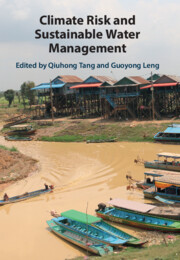Book contents
- Climate Risk and Sustainable Water Management
- Climate Risk and Sustainable Water Management
- Copyright page
- Contents
- Contributors
- Preface
- Acknowledgements
- Part I Water-Related Risks under Climate Change
- 1 Pluvial, Fluvial and Coastal Flood Risks and Sustainable Flood Management in the Pearl River Delta under Climate Change
- 2 Flooding Risk in the Lancang-Mekong River Basin under Global Change
- 3 Spatial Drought Patterns in East Africa
- 4 Assessment of Global Water Erosion Vulnerability under Climate Change
- 5 Water Erosion and Its Controlling Factors in the Anthropocene
- 6 Climate Change Impacts on Saltwater Intrusion into Coastal Aquifers
- Part II Climate Risk to Human and Natural Systems
- Part III Sustainable Water Management under Future Uncertainty
- Index
- References
1 - Pluvial, Fluvial and Coastal Flood Risks and Sustainable Flood Management in the Pearl River Delta under Climate Change
from Part I - Water-Related Risks under Climate Change
Published online by Cambridge University Press: 17 March 2022
- Climate Risk and Sustainable Water Management
- Climate Risk and Sustainable Water Management
- Copyright page
- Contents
- Contributors
- Preface
- Acknowledgements
- Part I Water-Related Risks under Climate Change
- 1 Pluvial, Fluvial and Coastal Flood Risks and Sustainable Flood Management in the Pearl River Delta under Climate Change
- 2 Flooding Risk in the Lancang-Mekong River Basin under Global Change
- 3 Spatial Drought Patterns in East Africa
- 4 Assessment of Global Water Erosion Vulnerability under Climate Change
- 5 Water Erosion and Its Controlling Factors in the Anthropocene
- 6 Climate Change Impacts on Saltwater Intrusion into Coastal Aquifers
- Part II Climate Risk to Human and Natural Systems
- Part III Sustainable Water Management under Future Uncertainty
- Index
- References
Summary
The Pearl River Delta (PRD) is the largest megalopolis region in the world, which is located at the estuary of the Pearl River Basin and dominated by sub-tropical and humid monsoon climate. This unique geographical setting makes the PRD highly exposed to pluvial, fluvial and coastal floods. Under climate change, the changes in precipitation regime intensify precipitation extremes, especially at the sub-daily scale, leading to higher risks of pluvial floods in the urban areas and fluvial floods in the riversides. Coastal floods also become more extreme due to the intensification of tropical cyclones and sea level rises. Future projections from CMIP5 Global Climate Models (GCMs) agree on further increases in the risk of these three types of floods, despite the uncertainties in the magnitude of changes. To counter the rising flood threat, PRD cities have adopted various measures to prevent and mitigate flood hazards. Hard measures, such as the three-pronged approach for pluvial flood prevention in Hong Kong and reservoir regulations for fluvial flood prevention for riverside cities, have been successfully implemented. To achieve sustainable flood management for future extreme floods, non-engineering measures should be further improved for playing a more important role in flood warning, prevention and mitigation.
Keywords
- Type
- Chapter
- Information
- Climate Risk and Sustainable Water Management , pp. 3 - 28Publisher: Cambridge University PressPrint publication year: 2022
References
- 1
- Cited by

